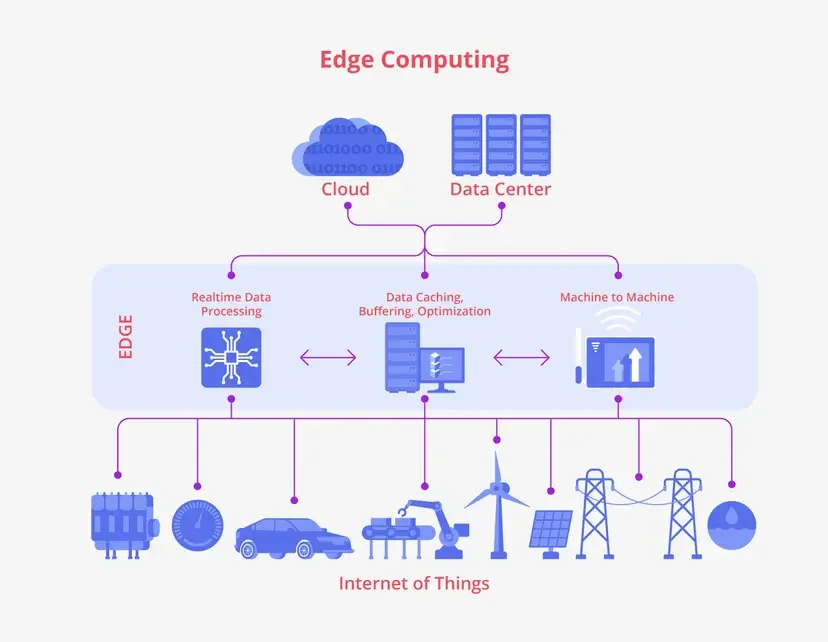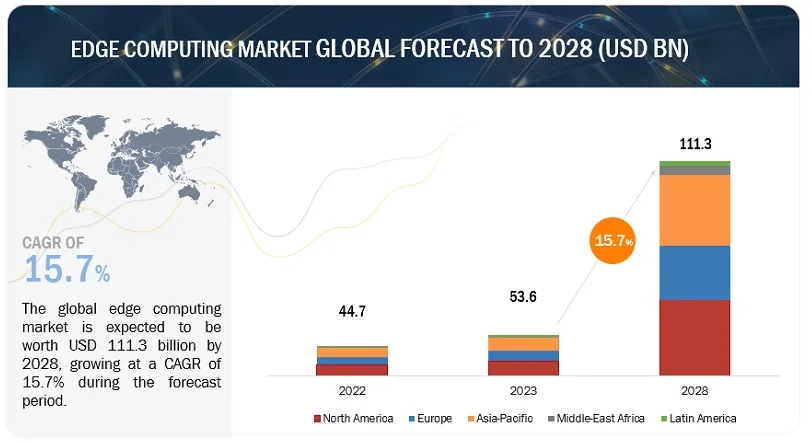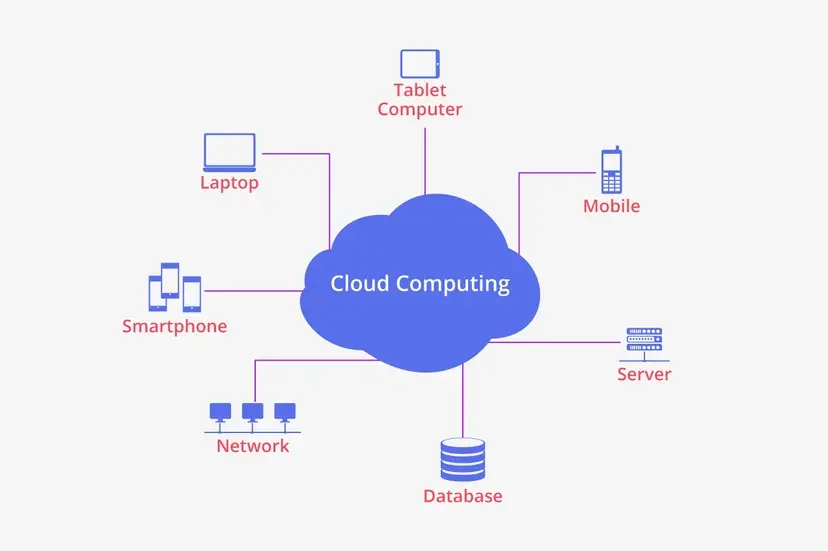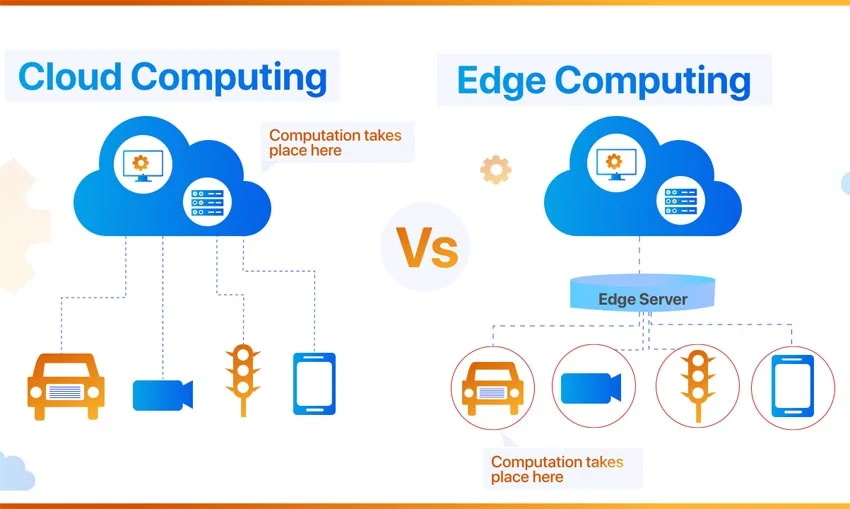The groundswell of computing is shifting, and it’s happening in the periphery. Edge devices have been growing at exponential rates. Cloud computing will now need to address the needs of this new framework.
These two technologies are not exclusive of each other and go hand-in-hand. That’s why the adoption of cloud and edge computing will benefit one another, and you need to be ready for this!
When trying to find a place in the cloud, the first point to understand is that edge computing and cloud computing are not one and the same. If you are a small business owner, understanding the difference between them can help you make intelligent decisions regarding your tech.
What is Edge Computing?


Edge computing is a new way of deploying, managing, and using the cloud. It is an emerging technology that enables applications to be processed and stored closer to the end users to improve performance and reduce latency.


The market value of $53.6 billion in 2023 is projected to rise to $111.3 billion by 2028. From 2023 to 2028, the worldwide edge computing market is expected to develop at a CAGR of 15.7%.
Edge computing differs from traditional cloud architecture because it processes data close to the source and doesn’t rely on a centralized server farm or data center. It allows businesses to increase their agility while lowering costs. Edge computing aims to improve customer experiences by improving responsiveness and reducing application latency.
This can be achieved through asset intelligence that leverages sensor data at the edge of networks, allowing companies to deliver real-time insights into their products and services.
What is Cloud Computing?


Cloud computing refers to delivering computing resources over the Internet, including servers, storage, databases, networking, software, and more. Instead of owning and maintaining physical hardware, users can access and use these resources on-demand from cloud service providers.
This model offers flexibility and scalability, allowing businesses and individuals to quickly scale up or down based on their needs without significant upfront investments.
In 2023, it is anticipated that end-user spending on public cloud services will be close to $600 billion. At $208 billion, software-as-a-service (SaaS) is expected to account for a third of total spending, followed by infrastructure-as-a-service (IaaS) at $156.2 billion and platform-as-a-service (PaaS) at $136.4 billion.
Cloud computing encompasses various services, including Infrastructure as a Service (IaaS), Platform as a Service (PaaS), and Software as a Service (SaaS), enabling users to run applications, store data, and perform tasks efficiently and cost-effectively.
In cloud computing, shared resources, such as processing power, storage, and network bandwidth, are provided to computers and other devices as a utility, similar to the electricity grid. Cloud computing, similar to public utilities, relies on sharing resources to achieve coherence and economies of scale.
Edge Computing Vs. Cloud Computing Comparison Table


The following table compares these two technologies:
| Aspect | Edge Computing | Cloud Computing |
| Definition | Processing data near the data source or device. | Providing resources and services through remote data centers. |
| Location | Close to the data source or device, often at the network edge. | Centralized data centers at various geographical locations. |
| Latency | Offers low latency, ideal for real-time applications. | Latency varies based on network distance and congestion. |
| Data Processing | Localized processing, suitable for quick analysis. | Centralized processing, suitable for complex computations. |
| Scalability | Limited scalability due to proximity and local resources. | High scalability with on-demand resource allocation. |
| Resource Dependency | Depends on local device capabilities and connectivity. | Relies on internet connectivity for resource access. |
| Cost | Lower data transfer costs as less data is moved externally. | Ongoing costs for services, data storage, and transfers. |
| Flexibility | Limited global scalability due to localized nature. | Highly flexible, can scale globally as needed. |
| Reliability | Prone to device failures, potentially affecting processing. | Redundancy and failover mechanisms enhance reliability. |
| Security | Data can be more secure due to localized processing. | Data security relies on cloud provider’s measures. |
| Use Cases | IoT devices, real-time analytics, low-latency applications. | Web applications, data storage, complex computations. |
| Examples | Smart sensors, self-driving cars, real-time monitoring. | Web hosting, virtual machines, big data analytics. |
| Data Storage | Limited local storage, suited for immediate processing. | Vast storage options, suitable for large datasets. |
| Management Complexity | Simpler management due to localized nature. | More complex management of distributed resources. |
| Initial Setup Time | Generally quicker setup, especially for edge devices. | Setup time can vary, involves provisioning resources. |
| Internet Dependency | Less dependent on consistent internet connectivity. | Requires reliable internet connectivity for access. |
| Scalability Dynamics | Limited scalability with physical constraints. | Elastic scalability with virtualized resources. |
Harmony Between Edge and Cloud Computing: Working Together for Success
Despite the expanding use of edge computing and the predictions of the end of cloud computing, Bernard emphasizes the significant lack of proven data caused by an inadequate analytical framework. Although helpful, edge computing is one of many solutions to the complex problems that IT suppliers and businesses face.
The fact that it only covers some applications in various scenarios emphasizes how vital cloud computing will continue to be in the IT landscape of an enterprise. To illustrate this viewpoint, Bernard uses an instance featuring an IoT gadget with processing capability and Azure functionality.
This example shows how real-time code can protect an IoT device by immediately stopping its activities in case of a severe malfunction while allowing other application parts to run in the Azure cloud. This integration of edge and cloud technologies frees The high-value device from a pure dependency on cloud infrastructure. It proves that edge and cloud computing coexist and work together to plan IoT devices’ remote operation, deployment, and management.
This confirms cloud computing’s ongoing relevance because it continues providing edge computing with real-time data analytics and other solutions crucial for corporate success.
Use Cases of Edge Computing and Cloud Computing
In the past, businesses were forced to choose between the benefits of cloud computing and edge computing. But now, it’s possible to use both platforms to create an end-to-end solution that delivers a massive boost in performance and efficiency.
The best way to understand how this works is by looking at some of the most common use cases for cloud and edge computing.
Use Cases of Edge Computing
Edge computing can be used in various use cases like industrial automation, smart cities, remote monitoring, etc.
- Industrial Automation: Edge computing is an excellent fit for industrial automation. It allows sensors, controllers, and other devices to send data directly to the cloud without sending it back to central servers. This helps reduce latency and increase efficiency.
- Smart Cities: Smart cities use edge computing to optimize traffic management and public safety. For example, an autonomous car driving down a street can detect a pedestrian who has wandered into the road, sending that information directly to the cloud, where it can be analyzed and sent back to other vehicles in the area. This reduces wait times for decisions on whether or not to brake, making travel safer and more efficient.
- Remote Monitoring: Remote monitoring is another good use case for edge computing because it doesn’t require constant connectivity with a central server or database. Many applications, such as smart home devices, already operate on battery power and only use Wi-Fi when connecting to the cloud. With edge computing software installed on these devices, they can analyze data locally before sending it up when necessary — reducing latency and saving energy simultaneously.
Use Cases of Cloud Computing
Cloud computing has many different applications, including:
- Online E-Commerce Platforms: Cloud computing empowers e-commerce platforms to handle massive traffic loads and provide uninterrupted shopping experiences. The cloud’s scalability allows these platforms to swiftly adapt to varying levels of user demand during peak seasons, ensuring seamless customer shopping.
- Big Data Analytics: Cloud computing is an ideal platform for processing and analyzing vast volumes of data. Enterprises can harness the cloud’s computational power to perform complex data analyses, derive valuable insights, and make informed business decisions based on trends and patterns.
- Collaborative Office Applications: Cloud computing underpins collaborative work environments where team members can access, edit, and share documents in real-time from different locations. Tools like Google Workspace and Microsoft 365 rely on the cloud to ensure document synchronization, enhancing productivity and remote collaboration.
Advantages of Edge Computing Compared to Cloud Computing
Edge computing offers numerous advantages over traditional cloud computing, leading to a growing trend in its adoption. By reducing latency, edge computing makes feasible various use cases that were previously challenging due to data having to travel back to distant cloud servers.
Examples of these latency-sensitive applications include:
- Augmented Reality (AR) and Virtual Reality (VR) applications
- Autonomous vehicles
- Cloud-based gaming
- Smart grid systems
Moreover, when edge computing is hosted on-site at the customer’s location, it enhances data security compared to distant cloud servers. Data sent back to the cloud is susceptible to interception by potential hackers. Data privacy laws are also subject to the country where data is stored. For instance, European companies may prefer their data to remain within Europe to comply with GDPR.
Edge data centers address this concern, making edge computing particularly valuable for sectors like healthcare and manufacturing, where robust data security is vital. The precursor to edge computing was on-premise solutions. These legacy servers allowed secure data storage but lacked scalability and flexibility for running various applications.
Final Words: Will Edge Computing Replace Cloud Computing?
While edge computing offers distinct advantages, it won’t replace cloud computing. As digitization advances, both edge and cloud sectors will thrive. Cloud computing has significantly driven digital transformation by lowering data storage and processing costs.
Edge computing expands this by enhancing existing applications and enabling new ones. Edge and cloud work together. Many applications will utilize both, processing real-time data at the edge for lower latency while storing and processing larger data volumes in the cloud.
Discover the synergy of edge and cloud technologies exemplified by Taikun. Streamlining processes with real-time monitoring and cloud automation, Taikun optimizes user experiences while bolstering security and data protection. Explore Taikun today for free or consult with our experts to receive personalized guidance.





